Whenever there is a major disaster, there is chaos. People start to worry about food security, and there is unrest. But that may be just the beginning. You need to think about what would happen if you didn’t have food stockpiled. What happens in a blizzard? An EMP attack? Loss of work? By stocking up on non-perishable foods, you can increase your chances of survival and stay comfortable for much longer than those who haven’t prepared.
When you are selecting foods for a stockpile, consider the following:
- You might not have electricity, so you need foods that can be stored without refrigeration or freezing
- Most foods will require repackaging to have a long shelf life
- You want minimum bulk but the maximum nutritional benefit
- Avoid junk food and “snack” foods that contain empty calories
With that in mind, let’s have a look at the best survival foods to stockpile for emergencies and SHTF scenarios:
List of Top Non-Perishable Survival Foods To Stockpile
1. Salt
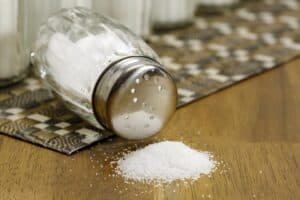
Salt is an essential item. Humans cannot live with sodium, for one. Secondly, you can use salt to season cooked meals and make rations taste better. Lastly, salt is needed for preserving items, such as meats, or for pickling vegetables.
2. Sugar

Much like salt, you need sugar to preserve fruits and vegetables. With a little sugar, you can easily can enough fruits and jams to get you through winter. Sugar can also help with food fatigue, which is bound to happen when you are eating the same emergency rations over and over.
3. Honey

Not only does honey keep for a long, long time, but it also has more than one use. Aside from giving a sweet flavor to coffee, tea and topping bread or oatmeal, you can use honey to boost your immune system. Honey also has anti-fungal and antibacterial properties. Make sure you get real honey. Fake honey has fillers and other things in it that hamper its healing abilities.
4. Baking Powder

Cheap and easy to store, you are going to need this leavening agent for making bread and other recipes.
5. Baking Soda
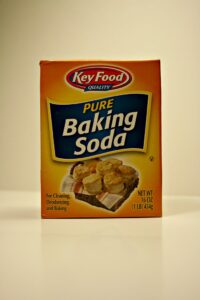
Another cheap ingredient with long shelf life. Baking soda can be combined with some regular distilled vinegar to help give bread a little rise. You can also use baking soda to deodorize and clean up. Just be sure to keep the boxes sealed up in a dry space before opening to keep them fresher longer.
6. Dry Yeast

When you have both brewer’s yeast and baking yeast on hand, you can make dozens of foods and beverages. You can use yeast to brew up beer and wine, make chocolate, add extra protein to your diet, or even as skin and hair treatments. If you are feeling adventurous, you can also purchase nutritional yeast, which is popular among vegans, as a cheese replacement.
7. Oils

Oils with healthy fats, like olive oil, coconut oil, and avocado oil, are an ideal base for sauces and dressings. Aside from cooking, oil can serve plenty of uses to help make a SHTF scenario much less chaotic. For instance, you can use oil for emergency candles and lighting when the lights go out. Coconut oil can be used as soap since it has antibacterial and anti-fungal properties.
8. Oats/Oatmeal

Oats can last a long time on the shelf. Use them to make quick and hot cereals that are nutrient-dense and packed with protein. You can make oatmeal a dozen different ways, ranging from sweet to savory. Another reason you want oats is to make oat flour.
While going out and buying bags of regular flour might sound like a good idea, you need to remember that flour doesn’t keep well. Oils from wheat berries, for example, will accelerate spoilage. However, with a hand grinder or even a quick pulse in a small food processor, you can use quick-cooking oats to make oat flour, which is just as good as any other kind.
9. Dried Herbs
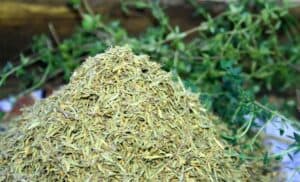
Spices keep for a long while and are great for more than adding flavor to food. Aside from salt and pepper, you should have chili powder, cinnamon, ginger, garlic, onion, bay leaves, parsley, oregano, and, if you have an adventurous palate, wasabi powder.
Not only will you be able to make tasty meals, but you can also get vitamins and minerals from herbs and spices. Many spices, including wasabi, can even protect against bacterial infections.
10. Dried Beans
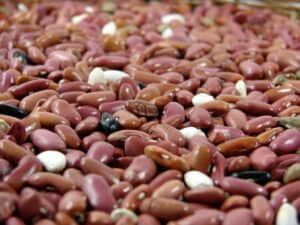
Any kind of bean you can think of—black beans, garbanzo (chickpeas), pinto beans, lima beans, edamame—contains healthy amounts of protein, fiber, amino acids, essential vitamins, and much more.
Dried beans are a bit more convenient in terms of storage than canned beans, especially since canned beans are often coated in chemicals from said cans, but you also need to consider preparation.
Dried beans will usually need to be soaked for several hours before they are soft enough to eat, but once you have them ready to go, you can make anything your heart desires, from soups to burger patties. It is also a wonderful way to feed a group of people at one time.
11. Instant Potatoes
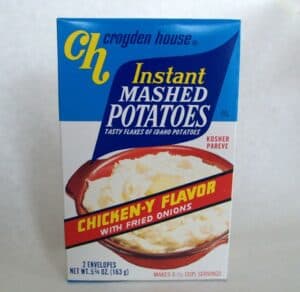
This is one item that has a number of benefits without breaking your budget. Instant mashed potatoes are lightweight, cheap, filling, and have a super long shelf life. All you need to make them is some boiling water and a spoon to stir, so the mixture fluffs up.
12. Dried Bone Broth

Also known as portable soup, dried bone broth is a favorite among travelers, survivalists, and even housewives for whipping up delicious meals. Unlike bouillon, dried bone broth is nutrient dense and, in its powdered form, can last for many years.
13. Lentils

Lentils can cook much faster than dried beans, are versatile, and have a perfect nutrient profile. You can make lentil soup, curries, and so much more. They are also lighter than bulk beans in terms of portability and storage.
14. Textured Vegetable Protein (TVP)

Although textured vegetable protein is a standby for vegetarians and vegans, it is a great form of protein to have around for emergencies. TVP is lightweight and has little to no flavor so that it can be added to almost anything. Like tofu, it takes on the flavors of whatever it is cooked with.
15. Brown Rice

Try to avoid white rice and ultra-processed whole grains. Instead, opt for brown rice. Not only is it caloric, but it has a good amount of protein, fiber, and even iron. Because of this, rice is excellent for survival situations. There is one disadvantage: It can take long periods to prepare. Some brands take around 7 minutes to get tender, while others make take around an hour or more.
Since SHTF scenarios don’t really give you the flexibility to burn through resources like propane or butane to boil water, you might want to line your pantry shelves with brown rice hot cereal or quick-cooking varieties, since most will only take around 6-8 minutes to prepare.
16. Seeds

Chia, flax, pumpkin seeds, sunflower seeds, and other seeds are high in macronutrients, are light and easy to store, and require little to no prep to taste good. You can also mix seeds into nut butters or trail mix for a satisfying snack. With a little water, chia seeds can bulk up oatmeal and help stretch more valuable ingredients.
17. Nuts

Similar to seeds, nuts are packed with nutrients, essential fatty acids, and protein. You can eat nuts alone, churn them into nut butters, add them to stews and curries, or roast them up.
18. Dehydrated Fruit and Vegetables

Freeze-dried and dehydrated fruits and vegetables are ideal for long-term storage, especially in bulk. Dried fruit and vegetables are lightweight, easy to pack, and rich in antioxidants and calories. You also get fiber to keep your digestive system healthy. You can also rehydrate freeze-dried vegetables (like carrots, seaweed, mushrooms, and even cabbage) and use them later in soups.
19. Instant Coffee

Have you ever had to go without a cup of coffee in the morning after getting into the habit of drinking it day in and day out? The last thing you want to deal with in an emergency is a raging headache and lethargy from caffeine withdrawal. While freeze dried coffee or instant coffee isn’t necessarily a priority, you should include it on your list.
Aside from saving you from a lack of energy, coffee can be used as a commodity in more drawn-out emergencies to help you get more critical items and can also boost the morale of everyone in your group.
20. Tea

Like coffee, tea is a luxury item purely for comfort most of the time. However, you cannot overlook the benefits of tea either. Herbal, green, and black teas have antioxidants to protect against illness.
Further, black and green tea can be used to make marinades, cool down sunburns, soothe rashes, get rid of foul odors, and even be used in compost mixtures for gardening. Just make sure the teabags are biodegradable.
21. Canned Meat and Fish

One of the best canned fish you can get is Alaskan wild salmon. This means the salmon has little to no contaminants or GMOs and will have loads of healthy fats and protein.
You can eat canned wild salmon straight from the can, and if you have any leftover fish, it will keep for about 3-4 days when kept in cool or refrigerated conditions. If refrigeration isn’t possible, try to share it with someone, so it is not wasted.
22. Jerky

Pick up some all-natural brands of turkey, bison, and beef jerky for snacking during emergency situations. Jerky, a form of dried meat, has been used by primitive people throughout the world and is still a widely accepted means of preserving meat. You can purchase jerky in bulk and have it shipped to you directly.
23. Summer Sausage

Like many cured meats, summer sausage can last for years in storage. The vacuum packaging is an additional plus. Summer sausage can be eaten with crackers and cheese or diced up and put in stews and casseroles. Quick, easy, and delicious.
24. Cheese

Cheese is great for protein and fat. Storing it is easy, too. All you need is to triple-dip the cheese in wax to make an airtight seal around it. You can then keep the cheese without refrigeration for many years. Even if mold forms, it will be on the surface. Just cut the mold away and enjoy.
25. Powdered Milk

Many people dislike the flavor of powdered milk, but when you have access to neither dairy milk nor milk alternatives, the powdered stuff is going to taste like heaven.
Powdered milk provides calcium and other nutrients that you are going to need during emergency situations. Additionally, it can be used much like liquid milk in recipes so that you can make sauces, breads, and even enriched drinks.
26. Peanut Butter

Peanut butter and other nut butters are comforting, add a sense of normalcy, and go with just about anything, from oatmeal to sandwiches or even in ramen noodles. If you have a grinder, you can buy nuts in bulk and make your own nut butters instead of storing them. However, most natural brands keep for a while.
27. Energy Bars, Protein Bars, and Emergency Ration Bars (ERBs)

Meal replacement bars, energy bars, protein bars, and emergency ration bars all have something in common. Regardless of the packaging, most of them have a glut of calories, nutrients, vitamins, and minerals. While most brands have a relatively short shelf life if you go by the printed expiration date, most of the popular brands, like Clif Bars, Power Bars, and Pro Bars, remain fine even after the two-year mark.
Emergency Ration Bars are a bit different in that they are designed to be a small chunk of nutritionally dense cornbread. While plain in appearance, each block can feed a full-grown adult for three days. ERBs have a shelf life of around five years. Also, the bars can be eaten even when you are thirsty because they are made with anti-thirst ingredients.
28. Powdered Super Greens

After disasters, communities often hurt for fresh produce. Fruits and vegetables are difficult to come by, and that can leave gaps in your nutrition. The good news is that you can get powdered superfood supplements that contain a rainbow of vegetables and fruits to boost your immunity, aid with injury and muscle recovery, and more.
You can also use powdered super greens like spirulina and chlorella to mimic juice for children.
29. Wheat Berries

Buy whole wheat berries. They can be planted to turn into wheat (for wheat grass and whole wheat) or ground down to make whole grain flour for baking. Sprout the grains for even more nutrition.
30. Couscous

Unlike some other grains on this list, dried couscous is an excellent substitute for rice. Most brands can cook in less than 5 minutes and requires very little additional prep.
31. Granola Bars

With all the granola bars available on the market these days, you can buy in bulk and have plenty to hold you over. Granola bars often include dried fruits, a little chocolate, protein from nuts and seeds, and pre-portioned. These are great options for children, too.
32. Seaweed

While it might not be the tastiest food to keep around, it is insanely nutritious and becomes very compact when dehydrated. Seaweed also has high levels of salt so that you can use it to flavor salads, rice dishes, soups, and more.
33. Pickled Vegetables

Learn how to make lacto-fermented or pickled vegetables, and you will have a great treat during emergency situations. Sauerkraut and other small batches of fermented vegetables can last a whole winter when stored properly.
34. Dark Chocolate

Chocolate, especially dark chocolate, contains antioxidants. Aside from that, chocolate can boost energy and spirits. When kept somewhere cool, chocolate can last for years.
35. Sports Drinks

You can buy powdered sports drinks blends to mix into water, or you can keep a stockpile of Gatorade or Powerade (or something similar). The reason you want these things close by is for the carbohydrates, electrolytes, and salt provided.
You can easily replenish fluid and rehydrate yourself with these beverages, particularly when there is a shortage of clean drinking water. Just make sure that the sports drink you choose is not loaded with sugar or artificial sweeteners.
36. Ramen Noodles

Although this isn’t the most nutritious option on this list, quick cooking ramen noodles and other cup noodle brands are definitely comforting and have long shelf lives. You can get ramen noodles in a range of flavors, too.
37. Pemmican

Easily one of the best survival foods for you to make, pemmican has been used by Native Americans for hundreds of years. It can save you from starvation and will last a very long time. Pemmican comes 100% from animal meat. In the past, Natives used elk, venison, and moose for their mixtures, but you can use a mixture of any meat with a good amount of fat. This means that seafood or lean meat, like rabbit or chicken, won’t work.
Here is an easy-to-follow pemmican recipe: 50 Plus Year Survival Super Food.
38. Dry Soup Mixes

You can make homemade dry soup mix for survival situations. This is a practice that still goes on around the world. Simply dehydrate some vegetables and mix them with powdered bone broth or some cubes of bouillon and store the mixture in a mason jar. When you are ready to use it, just add some water and noodles or pasta for an easy, wholesome meal.
39. Quick Cook Dry Pasta

Since regular dry pasta can take a long time to boil, opt to store quick-cooking varieties. Ideally, you want something that takes less than 10 minutes from start to finish. Then you can add it to pasta sauce, salads, soups, or anything else.
40. Hardtack Crackers

Hardtack has been utilized by numerous civilizations across the years, from early wayfaring sailors to the ninja in Japan. Hardtack can last a lifetime, and while it isn’t the most appetizing, it can save your life.
41. Jams and Jellies

Fruit can be preserved as homemade jam or jelly for months when stored correctly. The ingredients will retain most of their nutritional value, too. The sweetness is also great for dealing with food fatigue.
42. Water

Don’t forget about water. In certain situations, like blizzards and hurricanes, water can get shut off. You will want at least 1-2 gallons of water for every person every single day. That amounts to a lot of water if you have a larger family or find yourself trapped in a group.
Water is necessary for cooking, drinking, and hygiene, so don’t forget it.
43. Freeze-Dried Prepackaged Meals or MREs

One of the most recognized food options for bug-out bags and emergency stockpiles is Meal Ready to Eat or MREs. These packs of food have been used by the military to feed soldiers for weeks on end and can be stored for an incredibly long duration. Each package holds multiple items, offering up a lot of calories and balanced nutrition. One problem with MREs is that they are usually only found online from specific suppliers.
Freeze-dried meals, on the other hand, are a little tastier than MREs but have a disadvantage. You can only make them if you have hot water. That said, you can find freeze-dried meals for emergencies in big-name retail stores for reasonable prices.
Takeaway
The 43 pantry staples can be useful in emergencies, so stock up on them whenever you have the chance. No matter where you are located or what the situation may be, it is crucial to be prepared for the worst. Having nutrient-dense foods on hand can protect you and your family and keep you strong—physically and mentally.
Would you add anything to this list? Have any other survival tips to share? Let us know!

